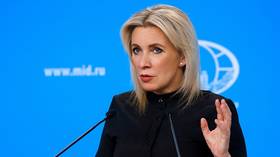How the New US-Afghanistan Peace Deal Rekindled a “Business Friendly Taliban”
from MintPress News:

resident Trump, who is up for re-election this year, has added another “peace” deal to his credentials, a deal that the president, his re-election campaign and his supporters have promoted as proof that Trump is willing and able to resist the U.S. foreign policy establishment and its ceaseless push to keep the U.S. embroiled in “forever wars.”
Yet, not unlike the much-criticized Israel-Palestine “peace” deal that was recently released by the Trump administration, there is more to the U.S.-Taliban “peace” deal than meets the eye. Indeed, while the deal will reduce and perhaps eventually even end the U.S.’ official military presence in Afghanistan, there is little indication that it will end the bloodshed or the country’s “shadow” economy that is awash in profits from the illegal drug trade and illegal mining.
Particularly telling is the fact that the CIA’s ever-growing presence in Afghanistan, which expanded during the Obama years and has continued to expand under Trump, will remain even as U.S. troops are set to begin to leave. Furthermore, many of the specifics of the deal — such as what the Taliban must do in order to ensure that the U.S. continues to withdraw troops — are remarkably vague, meaning that U.S. troop withdrawal could easily be paused or outright canceled at the Trump administration’s whim at any point during the 14-month timetable for withdrawal that has been established.
Of course, that 14-month window expires well after the 2020 election, likely shielding Trump’s re-election efforts from any potential fall-out over a deal that contains few specifics in its current form as well as several “secret” annexes, which will ensure that a continued CIA presence and a sizable contingent of U.S. “counter-terrorism” forces may remain in Afghanistan indefinitely.
In addition, Afghanistan’s “war oligarch” class, who grew rich from the corruption that has marked post-invasion Afghanistan, have praised this accord. This is notable given that these oligarchs, many of whom currently live in the United Arab Emirates (UAE), have opposed and railed against U.S. troop withdrawals in the past. Adding to the oddity is a push in Western mainstream media to describe a post-invasion Afghanistan as “open for business.”
Yet, it is the illicit economic activity of Afghanistan, namely its opium trade, that will likely define whether this new deal is ultimately successful, as Afghan opium is a major source of revenue, not only for the Taliban but also for the CIA — and thus of major interest to both parties. It is hardly surprising then that the deal contains an annex pertaining to future CIA operations in Taliban-controlled areas.
The myriad factors in play regarding this latest “peace” deal suggests that there are several motives behind its recent signing and promotion. While the deal certainly plays into the hand of Trump’s reelection aspirations, rekindling the Taliban’s old alliances with the UAE and Saudi Arabia at the expense of their ties with Iran is another possibility as are efforts to bring Afghanistan into the fold of several U.S.-backed Central Asian infrastructure projects that seek to stymie the success of similar projects promoted by U.S. rival states in the region.
Whatever the exact motivations behind the current deal are, its long-term success will be determined by long-standing U.S. business, government and intelligence interests in the country and whether or not the Taliban will pose obstacles to those interests, not by any real desire to bring home U.S. troops and wind down American “forever wars” abroad.
Landmark agreement or election year theater?
The “landmark agreement” signed by the U.S. and the Taliban on February 29 was not a final deal but a preliminary agreement on which U.S. officials are not authorized to publicly comment and the specifics of which have not been publicly released.
Yet, just a few days after it was signed, the U.S. bombed the Taliban in alleged retaliation for attacks for which no one claimed responsibility, which is quite possible given the factional nature of the fighting in Afghanistan and the Taliban itself. There is also the fact that some of the country’s deadliest armed groups are paramilitaries created and backed by the CIA and the CIA’s control over the actions of said groups is alleged to have “waned” in recent years, making them essentially rogue death squads. However, the U.S. has asserted these attacks were committed by the Taliban.
The Taliban easily could have committed these attacks without technically having violated the deal, however, given that the “peace” deal does not “obligate the Taliban to abstain from any specific actions after an initial week of Reduction in Violence” that ended last weekend, according to CBS News. In other words, the “peace” deal does not include a ceasefire but instead holds that a ceasefire will be negotiated as part of “intra-Afghan talks” between the Taliban and the U.S.-backed government based in Kabul. That government is currently led by former World Bank economist Ashraf Ghani, whose government has forged increasingly close ties with the CIA, and whose recent reelection was marred by fraud. Notably, Ghani’s main political rival who claims to have won the recent election was recently targeted during a mass shooting that took place last week and also followed the signing of the “peace” deal.
Loading...



